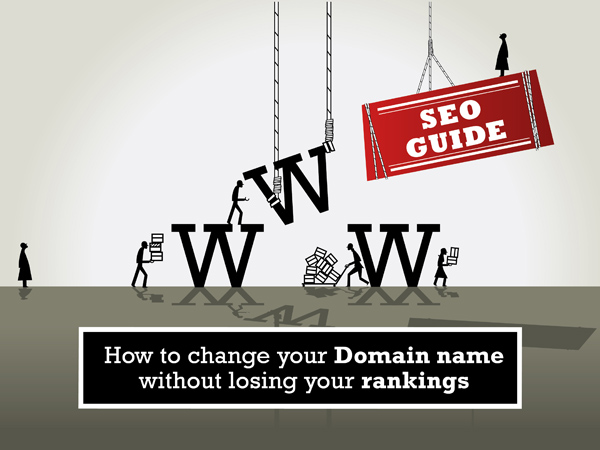SEO Guide: How to change your Domain name without losing your rankings
 Changing the domain name of your website can have a serious impact on SEO and organic traffic and generally it is not advised from SEO perspective. This is because each domain name is linked with several metrics (trust, authority, etc), characteristics (domain age, GEO location signals, etc) and above all the hyperlinks. In this SEO Guide we will explain the risks of transferring from an old domain to a new one and we describe in detail the steps that one should take in order to minimize the losses of search engine traffic.
Changing the domain name of your website can have a serious impact on SEO and organic traffic and generally it is not advised from SEO perspective. This is because each domain name is linked with several metrics (trust, authority, etc), characteristics (domain age, GEO location signals, etc) and above all the hyperlinks. In this SEO Guide we will explain the risks of transferring from an old domain to a new one and we describe in detail the steps that one should take in order to minimize the losses of search engine traffic.
Disclaimer: The changes below require you to have basic understanding of the various web technologies and they can heavily affect your SEO status. It is strongly recommended not to proceed to any of the below updates unless you are tech-savvy and you know what you are doing.
1. Register the new domain or purchase an old Domain
The first thing that you have to do is to acquire a new domain. Note that since the TLD of the domain (.com, .fr, .gr, .de etc) is often used as a GEO location signal, using a new TLD can affect your rankings.
Also be extra careful when you purchase an aged domain. There is always the risk that the given domain is banned by one of the major search engines. Do a bit of research on the history of the domain, check the previous WHOIS records, check if the domain has any indexed pages on the search engines, use Archive.org to see how the website used to look in the past etc. Also add the new domain in Google’s & Bing’s Webmaster Tools in order to see their statistics and check whether you have received any warnings about those websites. If you believe that the domain has been banned due to spamming, filing a reconsideration request can be a good idea before you transfer your website.
2. Upload a “coming soon” page
By uploading even a single HTML page on your new domain few weeks before moving to it you allow search engines to crawl and index the new website. Moreover have in mind that most search engines try to detect the parked domains by using several classifiers. As a result by placing in your pages some content and by mentioning that this will be the location of the new website you help search engines detect that your new domain is a real website and not a parked one.
3. Transfer smaller parts of your website (Optional)
If possible don’t transfer directly all of your pages of your website to the new location but instead try moving smaller segments of it. For example you might want to transfer first a particular subdomain and test whether the transition was successful. Then few weeks later after you validate that your rankings have not been seriously affected you can proceed to moving the rest of the website. The same applies when you want to merge several different websites into one new domain. You can start with the one that receives the smallest amount of traffic and then focus on the other ones. Even if this step is optional it is highly recommended because it can help you avoid serious SEO problems.
4. Upload your pages to the new Domain
The next step is to upload the pages/images/files of your website to the new website. If you decide to change the structure, folders or paths on the new site, make sure you note down the changes because on the next step you should be able to map the old page URLs to the new ones.
5. Redirect the Old pages to the New ones
Once you upload the content on the new website you will need to place redirects from the old domain to the new one. Note that this should be done on the page level, meaning that each page of the old site should be redirected to the new URL of the page on the new domain. Map each page to the appropriate new URL and don’t just redirect all of them on the new homepage.
It is strongly recommended to use 301 redirects because in this way you manage to pass to the new website most of the metrics, characteristics and statistics (PageRank values, links, anchor text data etc). Nevertheless note that 301 redirects should be used for permanent changes. If your plan to undo this change on the future you should use a 302 redirect (note though that 302 redirects do not pass PageRank, anchor text or any other info/metrics to the new target pages).
6. Use the Change of Address tool in Google Webmaster Console
Another thing that you should do is use the Change of Address tool in Google Webmaster Console. After registering both the old and the new website to Google Webmaster tools you should specify that the old one has been transferred to the new address. The Change of Address tool works at the site level, which means that it clearly helps Google understand that this transition happened for the whole domain and not for specific pages of your site.
7. Update the important Backlinks
Even though the 301 redirects are supposed to pass most of the PageRank and anchor text data, it is strongly recommended to try to update the most important backlinks (links from reputable sources with high PageRank) that point to your old website and link directly to the new pages. Of course you don’t have to contact all the webmasters that link to your website, but instead focus only on the most important ones. In order to get a list of all the Backlinks of your website you can use the Backlink Analyzer tool or Google Webmaster Tools console.
8. Be patient & Keep it up-to-date
Changing your domain name is among the most major updates that you can do to your website. Be patient and make sure you dedicate time to test everything before you transfer your whole website. Also make that you will renew your old domain names regularly and that you will not let them expire. In this way you will not lose any referring traffic or PageRank that is coming from old backlinks. Last but not least don’t forget to maintain the 301 redirects from the old domain to the new one and to renew the change of address every 180 days.
If you follow closely the above steps and you test thoroughly the update, you will minimize the losses of organic traffic and you will not affect that much your SEO status. Don’t forget that you should never change your domain name unless you have no other option.
Don’t forget to share this blog post in you like it. 🙂

 31 Comments
31 Comments


